Lift Off Time (Subject to change) | November 23, 2020 20:30:12 UTC November 24, 2020 04:30:12 BJT |
|---|---|
Mission Name | Chang’e 5, a Lunar sample return mission |
Launch Provider | China Academy of Launch Technology (CALT) |
Customer | China National Space Administration (CNSA) |
Rocket | Long March 5 (CZ-5) |
Launch Location | Wenchang Space Launch Center, Hainan Island, China |
Payload mass | 8200 kg (18100 lbs) |
Where are the spacecraft going? | To the Moon (and back again)! |
Will they be attempting to recover the first stage? | No, but they are attempting to recover lunar samples in the 4th payload module! The landing will occur in the Siziwang Banner area of Inner Mongolia. |
Where will the first stage land? | It will crash into the South China sea |
Will they be attempting to recover the fairings? | No. |
Are these fairings new? | Yes. |
How’s the weather looking? | Seems to be on course! |
This will be the: | – 6th flight of a Long March 5, ever – 353rd launch of any type of Long March, ever – 35th orbital launch by China in 2020 – 7th launch from the Wenchang Space Center |
Where to watch | Chinese livestream Tim Dodd, the Everyday Astronaut, will be streaming at T-30 minutes; come ask questions and join the conversation live! |
What’s all this mean?
China is sending a sample return mission to the Moon! Chang’e 5 will be sent to the Moon on the top of a Long March 5 rocket. This is the same rocket that will eventually send people into deep space.
The Chang’e 5 mission!
China is attempting to achieve a lunar sample return plan. The aim is to complete a “soft landing” in the Mons Rümker area within the Oceanus Procellarum. (No, not Procol Harum, that’s a band – different thing).
The plan is to be operational for one lunar “day” (meaning two weeks). During this time, the goal is to obtain up to 2 kg of lunar “soil” or regolith. This could be from as deep as 2 meters (~7 feet) underground!
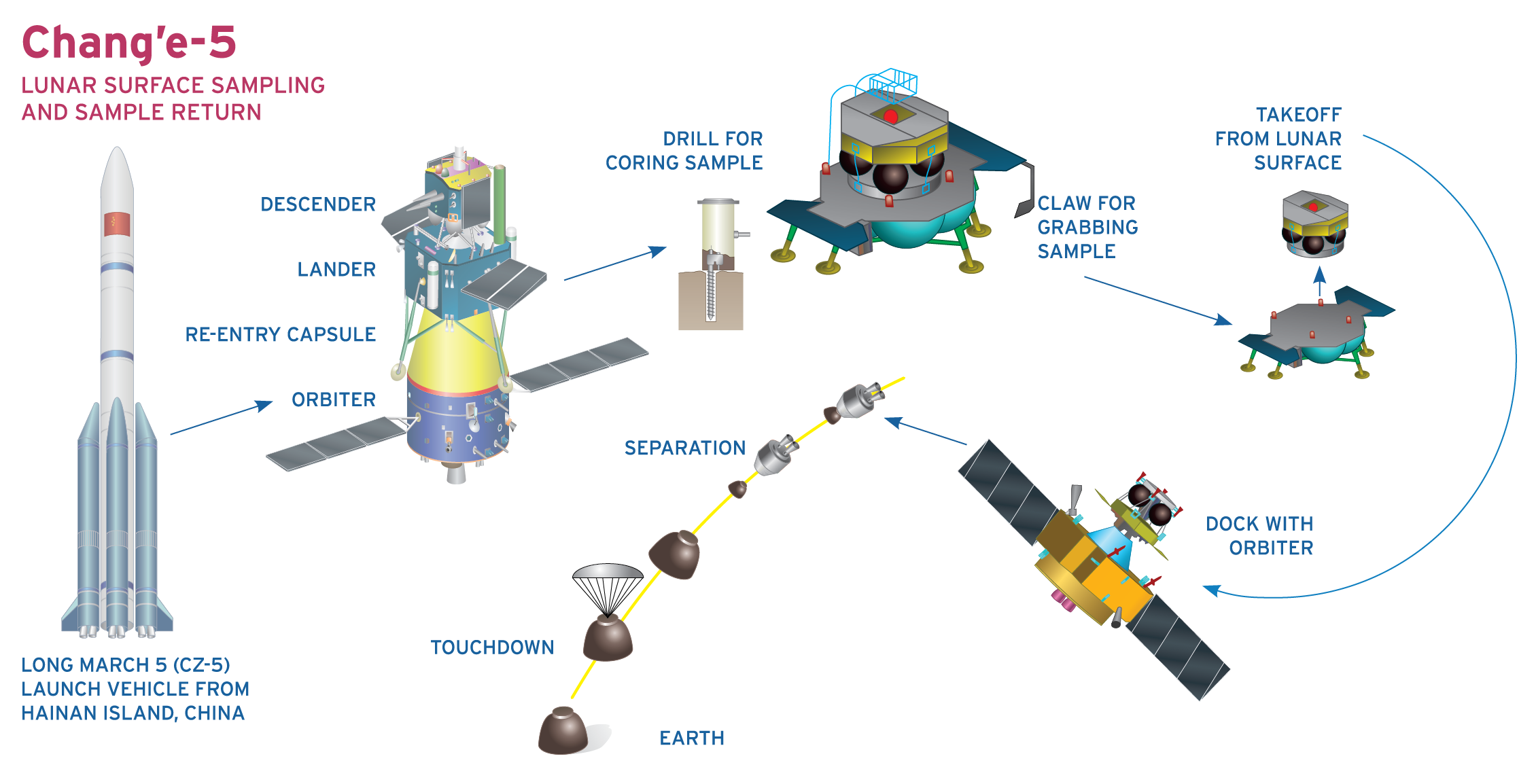
Having obtained the sample material, the return craft will come back to Earth, hopefully. Using the Earth’s atmosphere as an air brake, it will slow down from its immense speed. The craft will dip into the atmosphere more than once and skip out again. Finally it will land in largely empty grass plains in Inner Mongolia.
The mission was “rehearsed” previously with the Chang’e-5T1 test mission back in 2014. The goal of that mission was to test the return technology.
What’s the payload?
The payload consists of 4 modules, so bear with us while we explain. The payload is as follows:
- Orbiter
- Landing stage
- Ascent stage
- Return/re-entry module
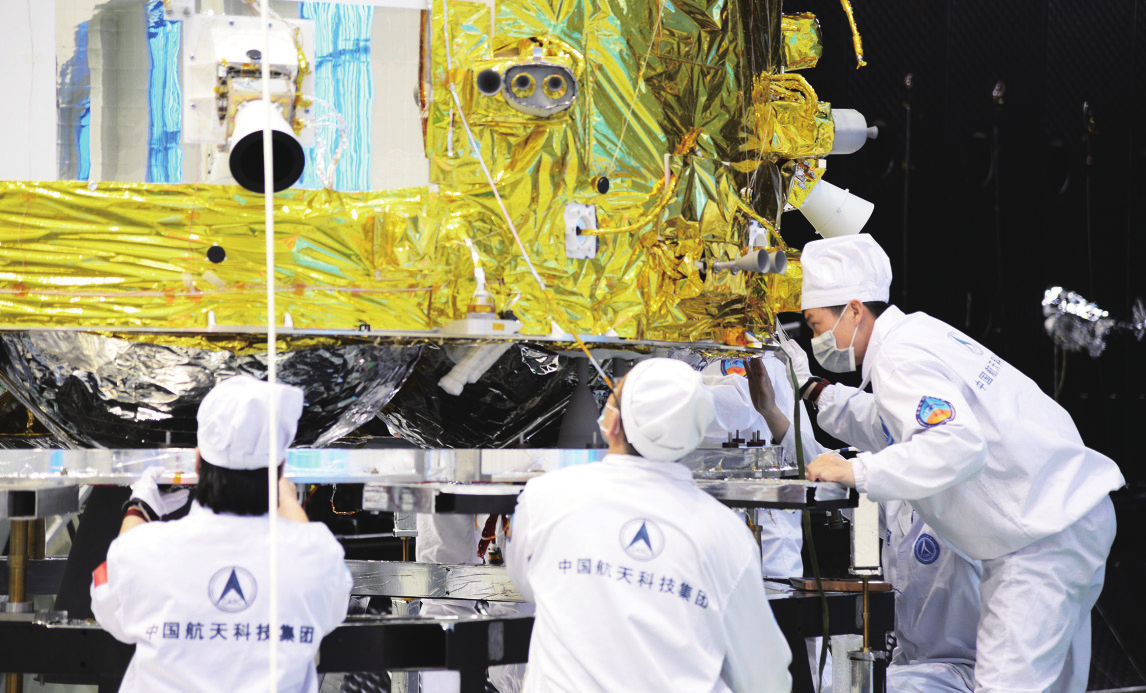
Only the landing and ascent stages will descend to the lunar surface. So, this mission features Lunar Orbit Rendezvous. The landing should take place about 6 days after launch. The orbiter and return modules will stay in lunar orbit. After obtaining the sample, the ascent module will dock with the return module in orbit. The return module will then come back to Earth as described earlier. This is expected to be about 23 days after the launch.
The Long March 5 rocket!
The Long March 5 is China’s first heavy lift rocket designed to not rely on hypergolic propellants. That is, propellants that ignite spontaneously on mixing. Instead, the rocket runs on both RP-1 (refined kerosene) and liquid hydrogen for fuel, depending on the stage. In either case it uses liquid oxygen (LOx) as the oxidizer.
The Long March 5 (CZ-5 and CZ-5B) is intended to replace all of the existing CZ-2, CZ-3, and CZ-4 vehicles currently still in service. This will likely end the dubious practice of launching rockets over towns and villages. Which is nice!
The CZ-5B version can deliver around 25,000 kg to Low Earth orbit (LEO). The CZ-5 version with the second stage can deliver around 14,000 kg to Geostationary Transfer Orbit (GTO). Not bad!
Boosters
The Long March 5 features 4 strap-on side boosters named CZ-5-300. Each booster uses 2 YF-100 engines.
The boosters use RP-1 for fuel and LOx for oxidizer. After their propellant is used, they detach and fall away while the first stage continues burning.
First Stage
The first central stage is named CZ-5-500. It uses liquid hydrogen as fuel and also LOx as propellant. Its burn time is an impressive 490 seconds! That’s more than 8 minutes!
It is powered by two YF-77 engines. This engine has a specific impulse of 310 seconds at sea level, and an amazing 430 seconds in vacuum.
The Long March 5 is powerful enough that its CZ-5B variant doesn’t even need an upper stage! Isn’t that crazy to think about?
Second Stage (not the CZ-5B variant)
Similarly, the second stage is also powered by liquid hydrogen. It uses a pair of YF-75D engines. These have a specific impulse of 442 seconds, and can deliver a DV of 4 1/3 km/s. The burn time is an additional 700 seconds. That’s over 11 minutes!
Optional third stage
So we are back to hypergolics finally. The third stage (if used) uses UDMH / N2O4 for propellants. (We don’t know for sure, but it seems likely this mission will use the third stage.) UDMH is Unsymmetrical Di-Methyl Hydrazine, nasty stuff. N2O4 is Nitrogen Tetroxide. This stage can burn for over 1100 seconds, which is 18 minutes.
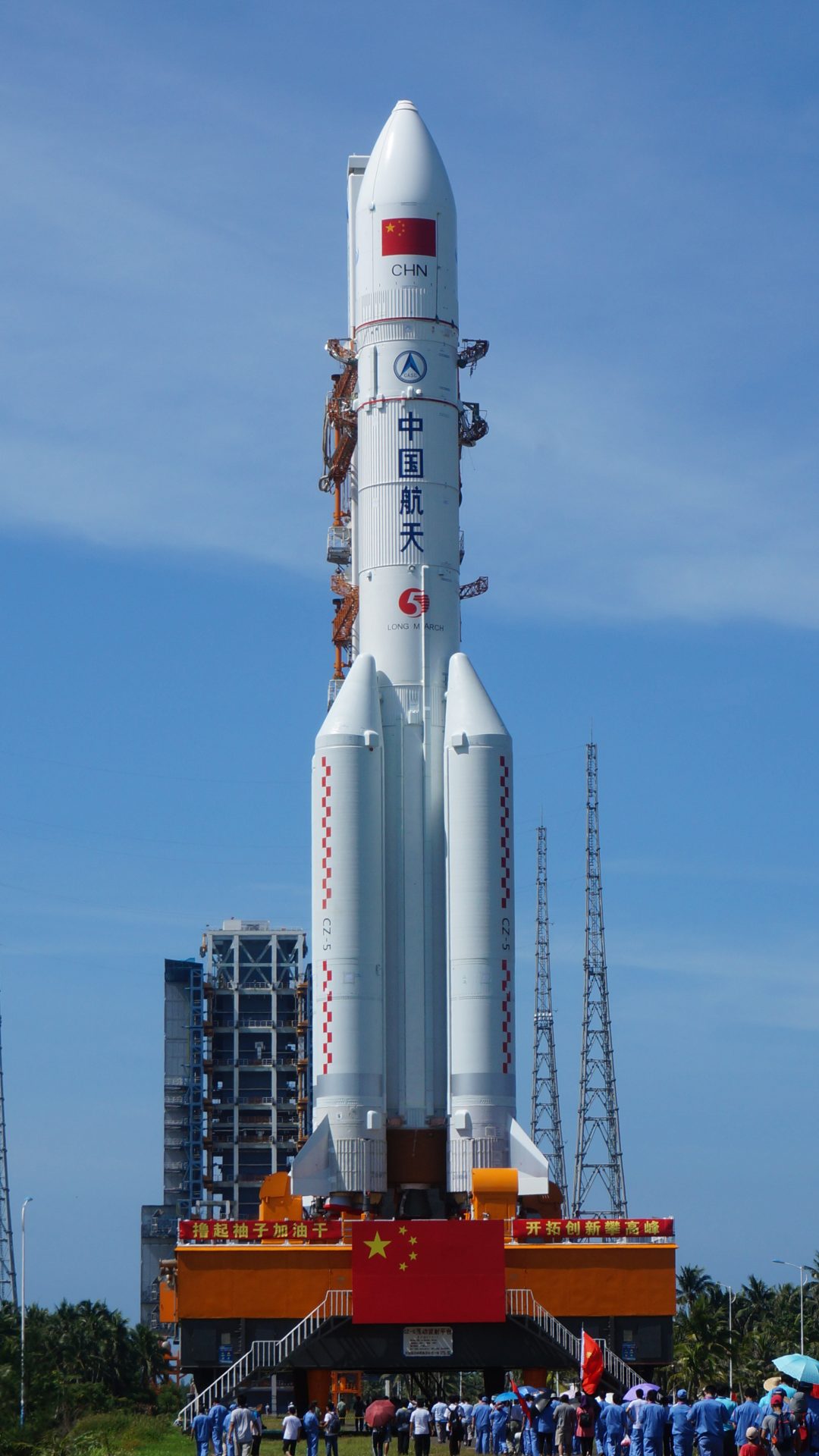
 )
)The Long March 5 is integrated vertically inside an enclosed launch tower. With between 5 and 7 hours before launch time, the lower section of the tower splits open. About 30 minutes later, the upper section follows suit, revealing the rocket on the pad.
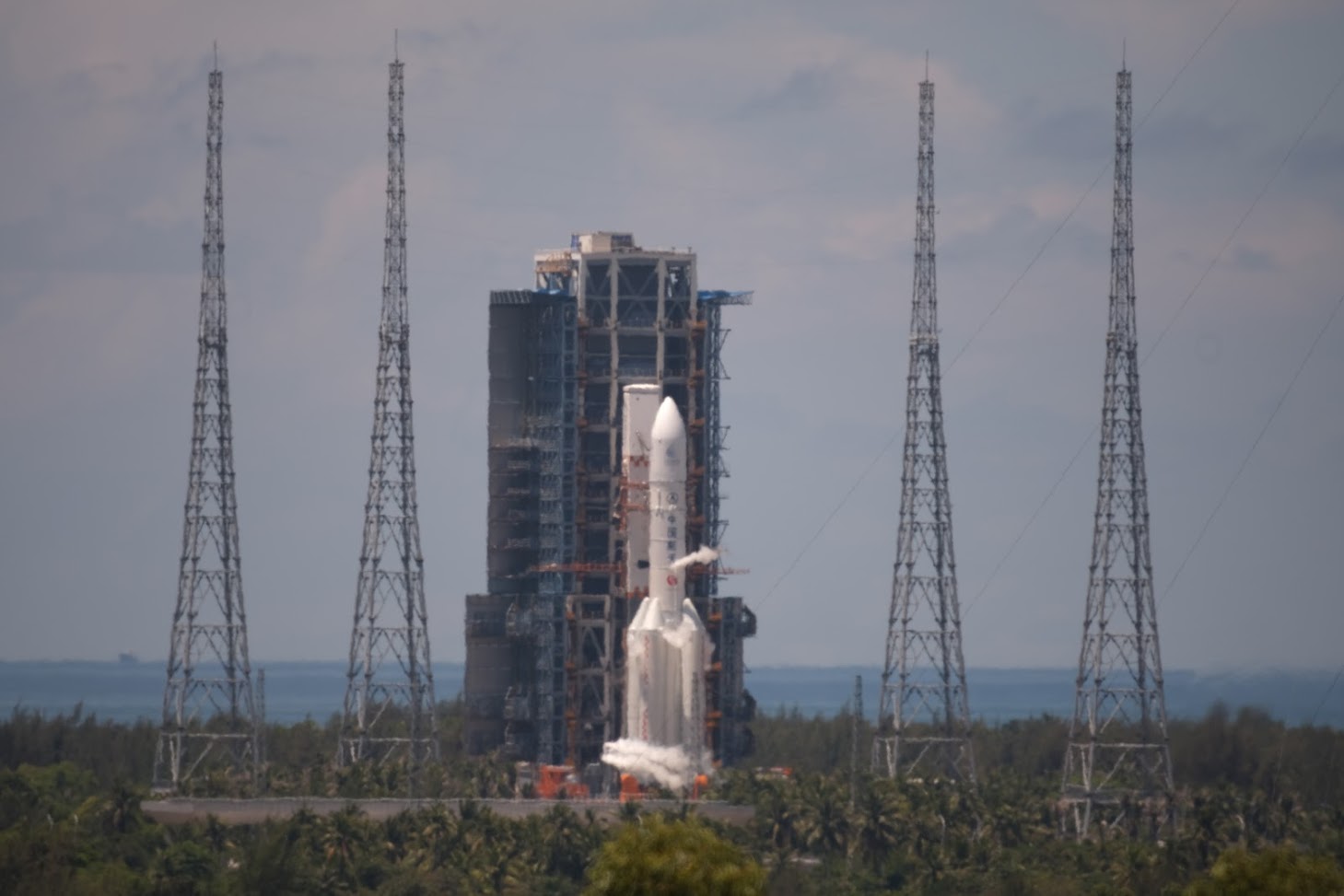
Any other noteworthy information?
This will be the first mission in more than 40 years to return Moon rock samples to the Earth. The last such mission being Apollo 17, with Gene Cernan and Harrison “Jack” Schmidt.
If the mission is successful, China will become the third nation to ever return surface samples from the Moon. Previously only the USA and the Soviet Union have achieved this.
NASA achieved this with the 6 successful crewed Apollo lunar landing missions. Meanwhile the Soviet Union had their own Luna robotic missions. The first mission, Luna 16 returned about 100 grams in 1970. Luna 20 returned just 55 grams in 1972. Later, Luna 23 landed OK in 1974 but it could not obtain a sample. The last mission, Luna 24 was able to gather 170 grams from a depth of 2 meters in 1976.
China isn’t doing this mission entirely on its own, interestingly. The European Space Agency (ESA) is providing tracking support as shown below.
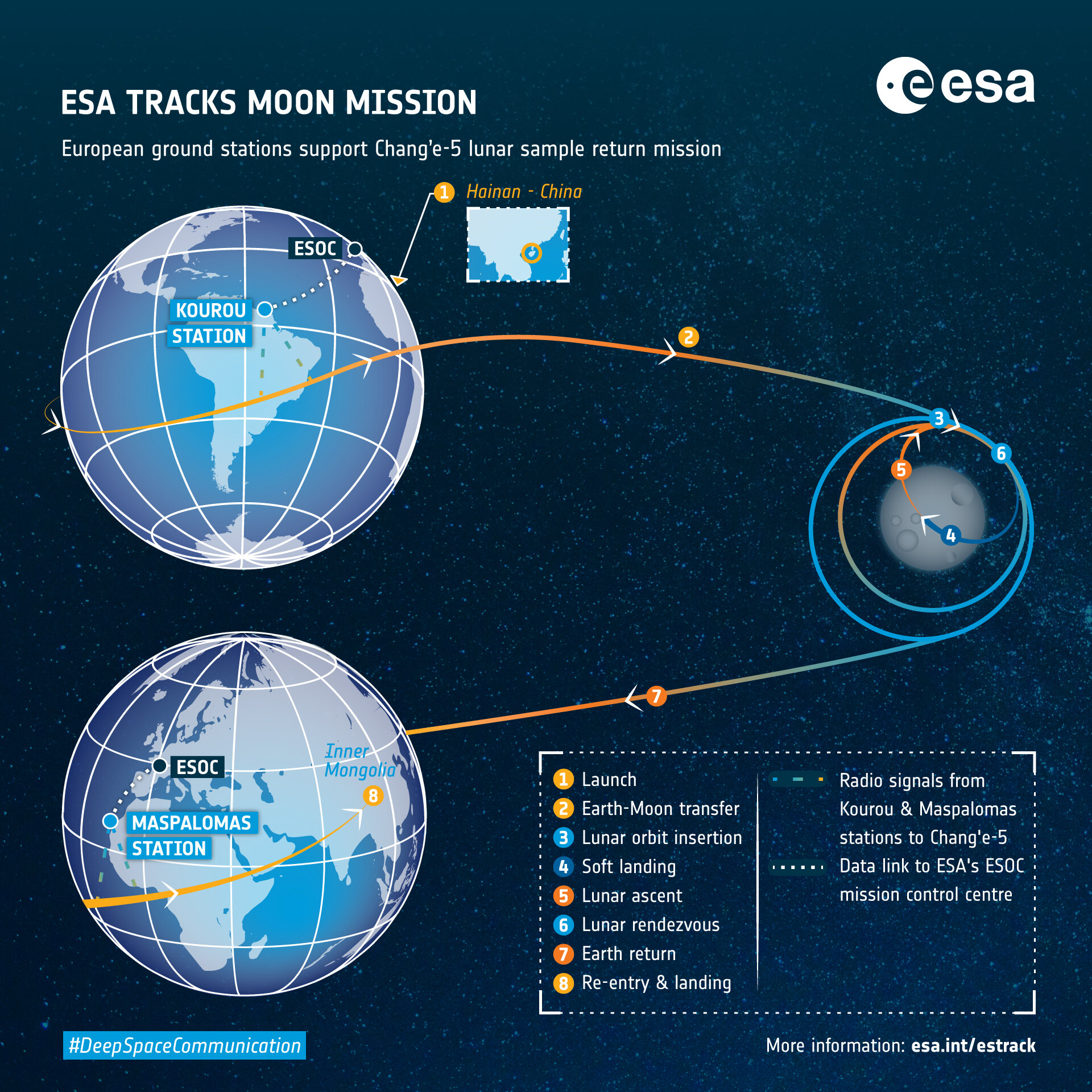
China has already soft-landed Chang’e spacecraft on the Moon, we should note. Chang’e is the Chinese goddess of the Moon. Initially, Chang’e 1 and 2 were lunar orbiters with no landers. This was considered “Phase 1” of China’s Moon mission program. Chang’e 3 and 4 had both orbiters and landers. This was “Phase 2”. Phase 3 is the sample return missions of both Chang’e 5 and 6.
The ultimate goal of the Chang’e missions is to lead to a crewed mission to the Moon in the 2030s.
If you want to know more about Chinese launches, check out the Chinese Space Program category.


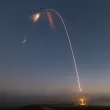

Very nice n informative write up… Really enjoyed reading this thank you very much
How are you getting these many information about an unpopular but a great a mission, it is astonishing!
Update the chinese livestreams link to this one https://youtu.be/K40_xSpRREM
Thanks!
A corrections: CZ5 is not intended to replace the entirety of CZ2, CZ3, CZ4 family. Instead they will be replaced by the CZ5, CZ6, CZ7, CZ8 series together. CZ6 and CZ8 will still be launched from inland instead Wenchang.
Good job andy #teamspace
How is Tim getting these camera views?
Is this a joke?
Will Tim do a live stream on the landing and ascending phase of this mission?
Only some GEO mission would use LM5 3rd upper stage, no 3rd stage for this mission